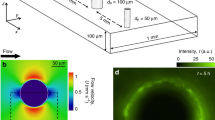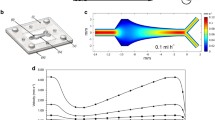Abstract
Computer-enhanced microscopy (CEM) was used to monitor bacteria colonizing the inner surfaces of a 1×3 mm glass flow cell. Image analysis provided a rapid and reliable means of measuring microcolony count, microcolony area, and cell motility. The kinetics of motile and nonmotilePseudomonas fluorescens surface colonization were compared at flow velocities above (120μm sec−1) and below (8μm sec−1) the strain's maximum motility rate (85μm sec−1). A direct attachment assay confirmed that flagellated cells undergo initial attachment more rapidly than nonflagellated cells at high and low flow. During continuous-flow slide culture, neither the rate of growth nor the timing of recolonization (cell redistribution within surface microenvironments) were influenced by flow rate or motility. However, the amount of reattachment of recolonizing cells was both flow and motility dependent. At 8μm sec−1 flow, motility increased reattachment sixfold, whereas at 120μm sec−1 flow, motility increased reattachment fourfold. The spatial distribution of recolonizing cells was also influenced by motility. Motile cells dispersed over surfaces more uniformly (mean distance to the nearest neighbor was 47.0μm) than nonmotile cells (mean distance was 14.2μm) allowing uniform biofilm development through more effective redistribution of cells over the surface during recolonization. In addition, motile cell backgrowth (where cells colonize against laminar flow) occurred four times more rapidly than nonmotile cell backgrowth at low flow (where rate of motility exceeded flow), and twice as rapidly at high flow (where flow exceeded the rate of motility). The observed backgrowth of Mot+ cells against high flow could only have occurred as the result of motile attachment behavior. These results confirm the importance of motility as a behavioral mechanism in colonization and provides an explanation for enhanced colonization by motile cells in environments lacking concentration gradients necessary for chemotactic behavior.
Similar content being viewed by others
References
Attridge SR, Rowley D (1983) The role of the flagellum in the adherence ofVibrio cholerae. J Infect Dis 147:864–872
Belas MR, Colwell RR (1982) Adsorption kinetics of laterally and polarly flagellatedVibrio. J Bacteriol 151:1568–1580
Block SM, Segall JE, Berg HC (1983) Adaptation kinetics in bacterial chemotaxis. J Bacteriol 154:312–324
Caldwell DE, Germida JJ (1985) Evaluation of difference imagery for visualizing and quantitating microbial growth. Can J Microbiol 31:35–44
Caldwell DE, Lawrence JR (1986) Growth kinetics ofPseudomonas fluorescens microcolonies within the hydrodynamic boundary layers of surface microenvironments. Microb Ecol 12:299–312
Davidson AM, Fry JC (1987) A mathematical model for the growth of bacterial microcolonies on marine sediment. Microb Ecol 13:31–45
De Weger LD, Van Der Vlugt CIM, Wijfjes AHM, Bakker PAHM, Schippers B, Lugtenberg B (1987) Flagella of a plant-growth-stimulatingPseudomonas fluorescens strain are required for colonization of potato roots. J Bacteriol 169:2769–2773
Guentzel MN, Berry LJ (1983) Motility as a virulence factor forVibrio cholerae. Infect Immun 11:890–897
Haefele DM, Lindow SE (1987) Flagellar motility confers epiphytic fitness advantages uponPseudomonas syringae. Appl Environ Microbiol 53:2528–2533
Ho CS (1986) An understanding of the forces in the adhesion of micro-organisms to surfaces. Process Biochemistry 21:148–152
Kefford B, Marshall KC (1986) The role of bacterial surface and substratum hydrophobicity in adhesion ofLeptospira biflexa serovar patoc 1 to inert surfaces. Microb Ecol 12:315–322
Kieft TL, Caldwell DE (1983) A computer simulation of surface microcolony formation during microbial colonization. Microb Ecol 9:7–13
Kirsop BE, Snell JJS (1984) Maintenance of microorganisms: a manual of laboratory methods. Academic Press, London, pp 35–40
Lawrence JR, Caldwell DE (1987) Behavior of bacterial stream populations within the hydrodynamic boundary layers of surface microenvironments. Microb Ecol 14:15–27
Lawrence JR, Delaquis PJ, Korber DR, Caldwell DE (1987) Behavior ofPseudomonas fluorescens within the hydrodynamic boundary layers of surface microenvironments. Microb Ecol 14:1–14
Marshall KC, Stout R, Mitchell R (1971) Mechanisms of the initial events in the sorption of marine bacteria to solid surfaces. J Gen Microbiol 68:337–348
Mayfield CI, Inniss WE (1977) A rapid, simple method for staining bacterial flagella. Can J Microbiol 23:1311–1313
Meadows PS (1971) The attachment of bacteria to solid surfaces. Arch Microbiol 75:374–381
Savage DC, Fletcher M (eds) (1985) Bacterial adhesion: mechanisms and physiological significance. Plenum Press, New York
Scher FM, Kloepper W, Singleton CA (1985) Chemotaxis of fluorescentPseudomonas spp. to soybean seed exudatesin vitro and in soil. Can J Microbiol 31:570–574
Simon R, Priefer U, Puhler A (1983) A broad host range mobilization system forin vivo genetic engineering: transposon mutagenesis in gram-negative bacteria. Bio/Technology 1:784–791
Van Loosdrecht MCM, Norde W, Zehnder AJB (1987) Influence of cell surface characteristics on bacterial adhesion to solid supports. Proc 4th Eur Congress on Biotechnology 4:575–580
Vesper SJ, Bauer WD (1986) Role of pili (fimbriae) in attachment ofBradyrhizobium japonicum to soybean roots. Appl Environ Microbiol 52:134–141
Author information
Authors and Affiliations
Rights and permissions
About this article
Cite this article
Korber, D.R., Lawrence, J.R., Sutton, B. et al. Effect of laminar flow velocity on the kinetics of surface recolonization by Mot+ and Mot− Pseudomonas fluorescens . Microb Ecol 18, 1–19 (1989). https://doi.org/10.1007/BF02011692
Issue Date:
DOI: https://doi.org/10.1007/BF02011692




